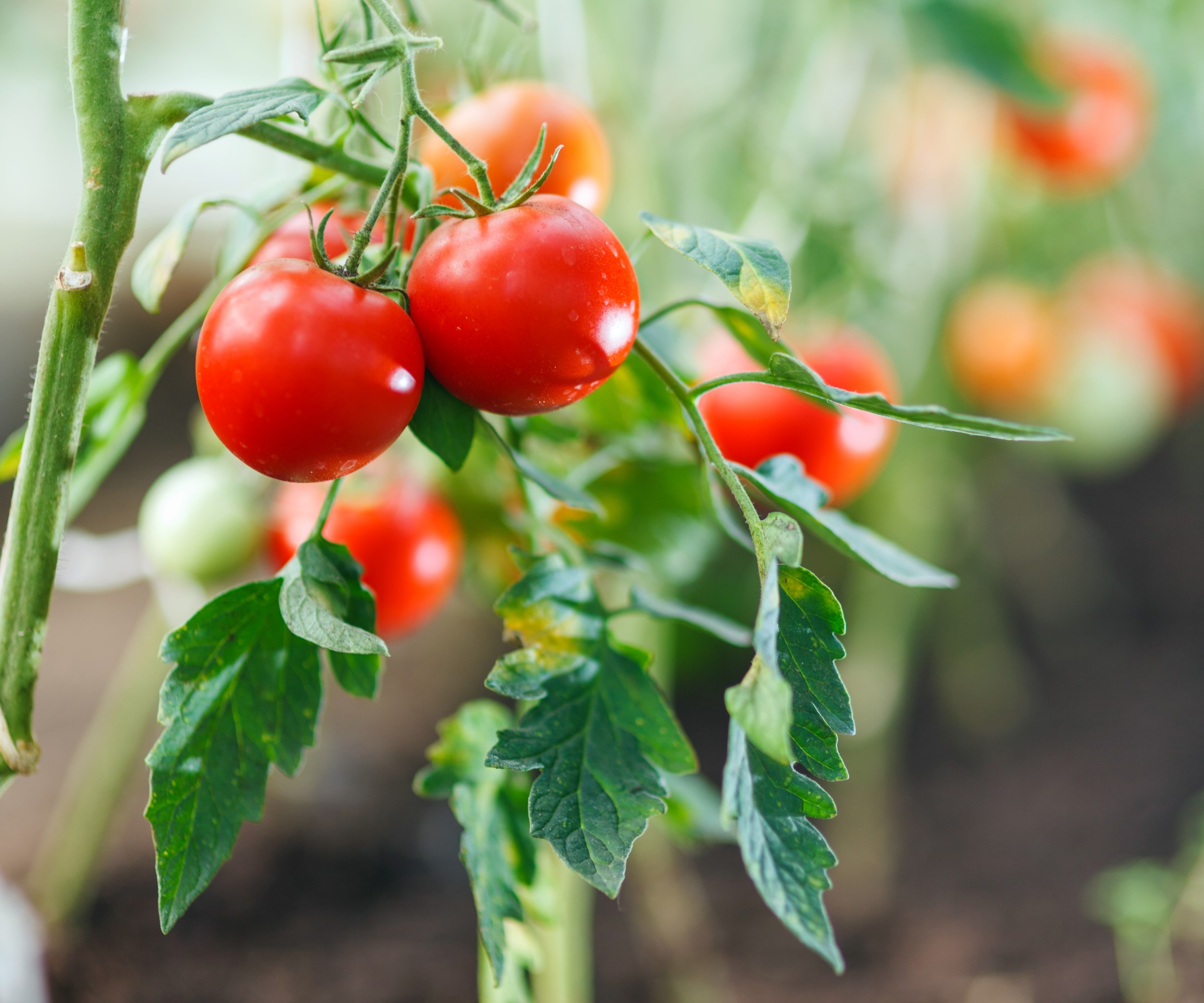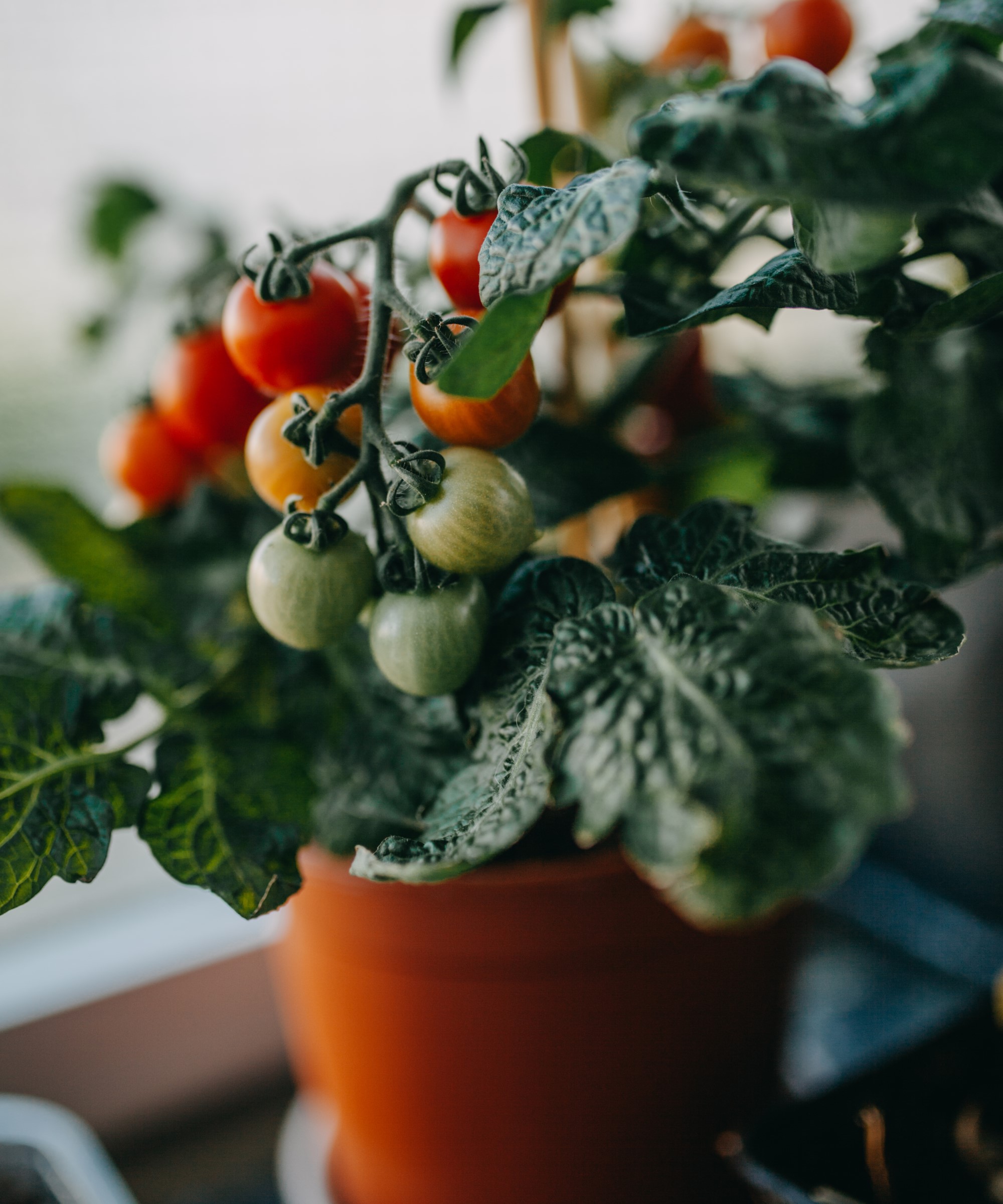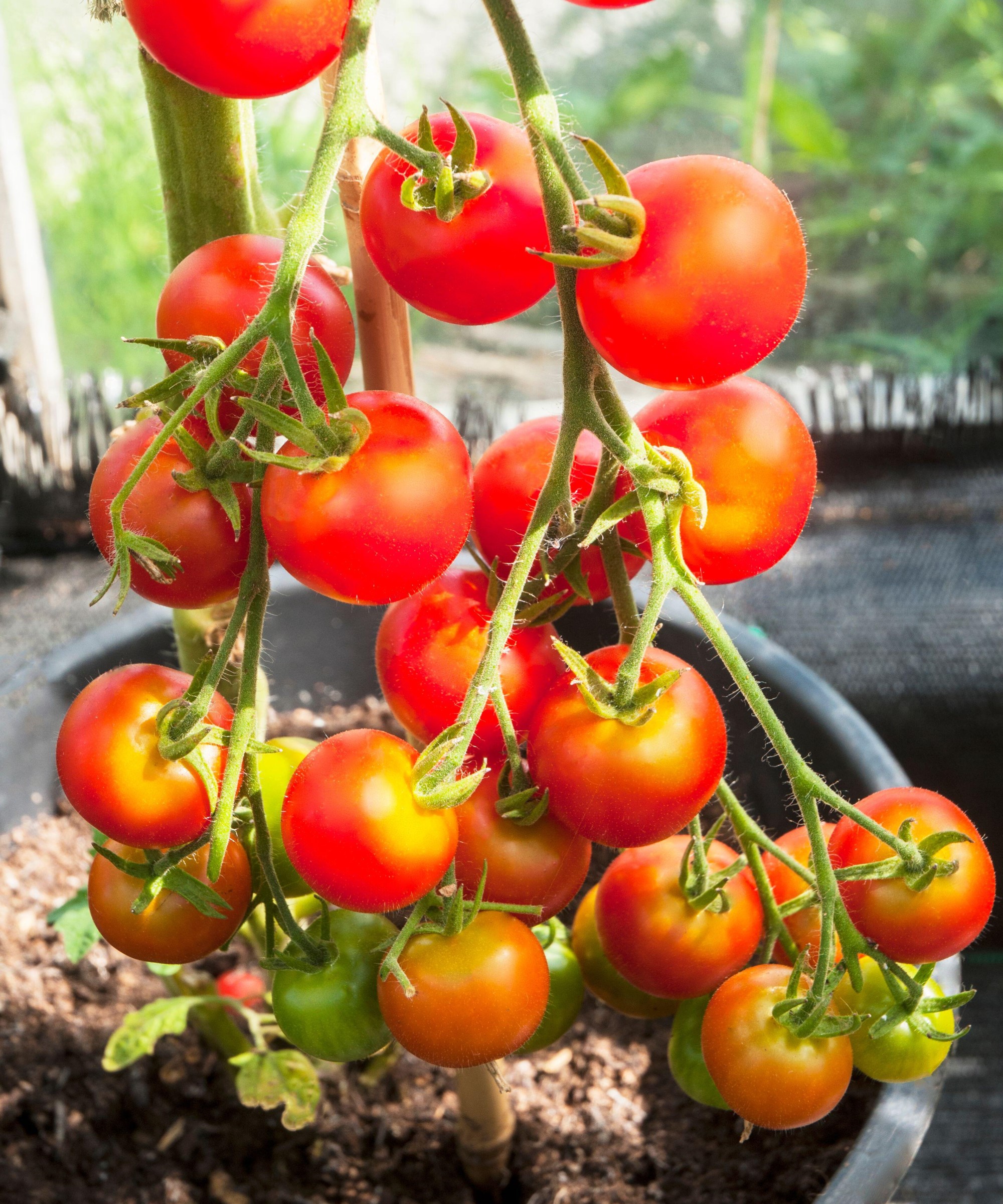How to grow tomatoes indoors – the best methods for success
If you don't have a backyard, you can still grow thriving tomato plants inside your home with these expert tips


Tomatoes are a traditional summer crop that everyone knows thrives on sun and heat. It may be less-well-known that it is also a crop that can be happily grown indoors.
When we claim you can grow tomatoes indoors, that does not mean undercover in a greenhouse. It is actually possible to grow tomatoes inside your house, such as by a south-facing window or in a sun room.
Growing tomatoes opens up a world of fruits to discover, you can grow tomatoes in different shapes, colors, and flavors than those commonly seen in the grocery store. Many of these variations can be grown indoors too, so even if you don't have a backyard or any outdoor space, it's no problem. It means anyone can get that experience of nurturing and harvesting homegrown tomatoes.

Tomato plants can succeed indoors given the right conditions
Can you grow tomatoes indoors?
You can grow tomatoes indoors successfully providing you can give the plants the proper care, heat, and light required to thrive. If you can essentially mimic a tomato's ideal outdoor conditions then it will grow and produce fruits happily – though that can be easier said than done.
By growing the crop indoors it does give you the advantages of avoiding outdoor pests and dealing with climate-related problems. This eliminates some of the risk and opens up the opportunity to have fresh and homegrown tomatoes year-round.
However, those advantages are lessened slightly for the fact that indoor-grown tomatoes need specific requirements and potentially artificial lighting to create the best environment. There is also limited space for plant growth, which can be mitigated by choosing smaller varieties of tomatoes, and you will get a smaller harvest of tomatoes overall than growing them in other scenarios.
Alex Tinsman, a gardener from How To Houseplant, advises any grower new to having tomatoes indoors to pick the sunniest spot possible, check plants regularly and ‘invest in high quality soil and lighting’ to lessen any risks.
Design expertise in your inbox – from inspiring decorating ideas and beautiful celebrity homes to practical gardening advice and shopping round-ups.
He adds: ’Monitor the plant closely for any signs of pests or disease, and address any issues immediately to prevent spread. Finally, be patient – indoor tomato plants may take longer to mature than their outdoor counterparts, but the reward of fresh, homegrown tomatoes is worth the effort.’
Despite all the potential drawbacks, anyone wanting to grow tomatoes indoors should not be too fazed as Emily Jones, tomato grower for over 30 years and creator of Tomato Mentor, advises: ‘Indoor tomato growing requires effort, attention to detail, and vigilance, but it can be a rewarding and feasible option for home gardeners.’

Emily has been growing tomatoes for more than 30 years, and she founded the blog Tomato Mentor as a way of helping others to improve their growing methods. She regularly writes about everything from watering tomato plants and common tomato pests to the best growing techniques people should use in their own space.

Light is a key factor for tomatoes growing indoors
How to grow tomatoes indoors
There are a few key details that need to be got right in order for tomatoes to be happy indoors. You need to take into consideration the pot, soil, light levels and ongoing maintenance of the plants as they grow.
Here's what you need to consider:
- Choose the right pot: To grow tomatoes indoors you need to give plants a large pot with a diameter of at least 12-14 inches and a depth of around 12 inches. Larger varieties do require larger pots, however by sticking to smaller types more suited to containers it reduces the need for an excessively large container. A 5-gallon pot that usually has a diameter of around 12 inches is ideal for smaller varieties of tomatoes. Any pot being used to grow plants must have good drainage holes – however remember that pots being used indoors will need a tray underneath to collect water coming through the drainage holes. When planting tomatoes, fill the container with a well-draining multi-purpose organic compost, ensure to firm the plant in when filling the hole with soil, and water the pot well.
- Light levels: Light is going to be a make-or-break factor for growing tomatoes indoors and tomatoes need at least 6-8 hours of direct sunlight per day. Find the sunniest spot in the house to grow indoors, for example a south-facing window, sun room, or enclosed porch would be an ideal spot for tomatoes. The plants want daytime temperatures of 65-75˚F, with slightly cooler temperatures at night. In lots of cases, indoor sunlight may not be sufficient to grow tomatoes indoors and the natural light may need to be supplemented with artificial grow lights. These can be fluorescent or LED grow lights that provide the light spectrum for healthy plant growth and can be installed above the plant’s containers. An example of such grow lights is the Lurious Smart WiFi Led Grow Light available at Amazon. If your plants are not being boosted with artificial overhead grow lights, then it is necessary to rotate the plants regularly to prevent them bending towards the natural light.

Smaller varieties of tomato will ripen quicker indoors than larger types
- Water: Keeping the moisture levels right for indoor plants can be tricky and judging how much water tomato plants need can require regular monitoring. Judging when to water plants is best done by inspecting the pot and feeling the soil around an inch down. Tomatoes that are grown indoors will need more watering than plants outdoors and they are crops that want a good amount of water while growing and developing fruit. Tomatoes like the soil to be moist, but they do not like their roots sitting in soggy soil. Regular monitoring and a consistent watering regime can help prevent common tomato issues, including tomatoes splitting and blossom end rot.
- Feeding: Feed plants with a slow-release balanced fertilizer just after they have been planted in their pot and then, once the plants start to set fruit, it is recommended to feed them weekly with a liquid tomato fertilizer that is high in potassium. An example of such a feed is the Miracle-Gro LiquaFeed Tomato, Fruits & Vegetables Plant Food available at Walmart.
- Pollinating: If you grow tomatoes indoors, then it pays dividends to give them a helping hand with pollination. Tomatoes are self-pollinating, so they do not need insects to transfer pollen from a different plant. You can help the plants with their natural process to help set fruits and potentially increase your harvest. A small oscillating fan can mimic the outdoor winds to help with pollination while Sean Lade, a gardening expert and founder of Easy Garden Irrigation, recommends how you can help the plant yourself. He says: ‘When the tomato is flowering, give the flowering branches a gentle shake to simulate wind. It's best to do this mid-morning to early afternoon hours, as this is when the flowers are most receptive to pollination. Repeat the process every couple of days to ensure the successful pollination of newly opened flowers.’

Regular watering will prevent the fruits splitting
Best types of tomatoes to grow indoors
Anyone wanting to grow tomatoes indoors can make life easier for themselves by choosing the right variety to grow. While any variety of tomato is capable of growing happily indoors, many varieties are simply too large for indoor growing and will require extra upkeep.
Always look for tomatoes that are sold as ‘patio’ or ‘bush’ varieties – the latter will also be referred to as determinate tomato plants and they do not grow as big as those that are classed as indeterminate. If you are growing determinate plants, then pruning tomatoes is not one of the required tasks.
Lindsey Hyland, founder of Urban Organic Yield, makes a few recommendations for tomato varieties more suitable to grow indoors. She says: 'It is important to choose a tomato variety that is appropriate for indoor growth. For anyone wanting to grow tomatoes indoors they should select a variety suitable for container growth such as 'Tiny Tim', 'Tomaccio' or 'Gardener's Delight'’.
By choosing smaller fruiting varieties – such as cherry tomatoes – and determinate plants it means they are ideal for growing tomatoes in pots and do not require lots of staking or pruning. There remains a wide variety of smaller tomato plants to be able to choose for growing indoors, including fruit in exciting shapes and colors. Plants can either be grown from seed and tomato seedlings transplanted into pots, or young tomato plants can be bought online or from garden centers.
Veranda Red Hybrid Tomato | $6.95 for 30 seeds at Burpee
A dwarf tomato plant – specially bred by Burpee – that grows to a foot high and wide. It is ideal for growing in pots on a deck, balcony, patio, or even indoors on a windowsill.

Gardener's Delight produces cherry tomatoes and is a variety ideal for growing indoors
FAQs
Can you grow tomatoes indoors all year-round?
It is possible to grow tomatoes indoors for 12 months of the year, however the hard task will be to create the ideal conditions year-round. As tomatoes want at least six hours of direct light per day and temperatures of 65-75˚F, you will likely need to supplement the light and heat for tomatoes to grow indoors in winter.
Indoor tomatoes will not develop flowers or fruits without enough light. If you want to harvest tomatoes year-round, and can give them the conditions they require, then you will also need to sow seeds throughout the year in order to have a supply throughout winter.
How long can tomato plants live indoors?
Tomato plants are traditionally sown as annuals, going from seed to harvest in one growing season. The plants tend to live for around six months and then succumb to colder temperatures. When the plants are grown indoors, indeterminate tomatoes can last for up to two years. That is because indeterminate tomatoes continuously set fruit. Determine tomatoes, the type usually more associated with growing indoors, tend to produce all their fruit at once. These varieties of tomatoes have a set lifespan and will only live for the one growing season indoors.
Learning how to grow tomatoes indoors may come with challenges, however, if you do not have any other way to grow tomatoes then it offers real potential. There will be many people who do not have a warm and protected environment to grow tomatoes, nor the climate to be able to grow them outdoors in a vegetable garden.
The opportunity to grow tomatoes inside the home offers a real alternative and one that will bring with it a feeling of satisfaction when you harvest those first homegrown tomatoes.

Drew has worked as a writer since 2008 and was also a professional gardener for many years. As a trained horticulturist, he worked in prestigious historic gardens, including Hanbury Hall and the world-famous Hidcote Manor Garden. He also spent time as a specialist kitchen gardener at Soho Farmhouse and Netherby Hall, where he grew vegetables, fruit, herbs, and cut flowers for restaurants. Drew has written for numerous print and online publications and is an allotment holder and garden blogger. He is shortlisted for the Digital Gardening Writer of the Year at the 2025 Garden Media Guild Awards.
